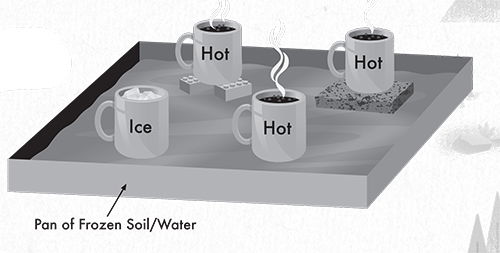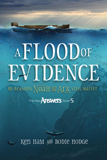Solid Ground: Permafrost Demonstration
Day Three Experiment: Investigating Earth Foundations in the Arctic
Part One
on October 9, 2017
Materials

Prepare 1 per table (or only 1 for an upfront demo).
- 9 x 13 cake pan with pre-frozen soil/water mixture (1–2 inches deep)
- 4 identical ceramic or glass mugs, 3 empty and 1 filled with ice
- 1 thermos of hot water
- Sponge
- 3 plastic building blocks or dominoes
- Timer
Pre-Prep
For Part Two of this experiment, please see Snowshoe Experiment
- Fill a 9 x 13 cake pan 1 inch deep with soil (a mixture of clay, peat, soil, dirt, mulch, etc.). Add water to create a slightly soupy consistency, then freeze.
Class Time Directions
- Place the mug of ice on the frozen soil.
- Fill the second mug with hot water and place on the frozen soil.
- Fill the third mug with hot water and place on the building blocks, which are on the frozen soil.
- Fill the fourth mug with hot water and place on the sponge, which is on the frozen soil.
- Don't let any mugs touch each other.
- Every 10 minutes, replace the hot water that has cooled.
- Observe and measure changes.
Today, you've been learning about the bedrock base of the Bible. As Christians, we have the Rock of God's Word to base our lives on! In the Bible, we read the story of a wise man who built his house (life) on a rock and a foolish man who built his life on sand. When a storm came, the foundation determined whether there was a disaster or if the house stood firm.
On the earth, people have many choices of where to live and what to use as the foundations for their homes, buildings, and roads. Do you know what kind of foundation your house is built on?
In the Arctic, foundations can include rock, sand, gravel, snow, ice, and permafrost. Permafrost is soil, rock, or sediment that has frozen solid for more than two years in a row. Permafrost can go down hundreds of feet into the earth. It makes a very strong and stable foundation as long as it remains frozen. If it begins to melt, though, it can turn into a soupy mess, causing the buildings above to gradually sink or collapse. Heat and pressure from buildings can cause permafrost to melt and foundations to fail.
Today, we're going to do a demonstration to show the effect of heat on a frozen foundation. Our scientific question is: What happens to the speed of melting when different amounts of heat touch frozen soil? We'll begin this demo, then check it occasionally throughout our time here.
We have frozen soil with water to create our own "permafrost." We're using a mug of ice, a mug of hot water, a mug of hot water on blocks, and a mug of hot water on a sponge. The blocks are like supports that hold up a building and allow air to flow underneath. The sponge is like an insulator to reduce the amount of heat touching the permafrost. Builders use insulation and air to keep as much heat away from the permafrost as possible. Every 10 minutes we'll get new hot water, and we'll observe any changes to the frozen soil.
During this time, introduce and work on the Snowshoe Experiment. (Or work on one of the craft options.) While working on it, check on the permafrost demo and when finished with the experiment, finish the demo with the following.
As it happens in real life, the heat turned areas of our frozen soil into a soupy mess. Other areas were not affected as much. Unless the foundations of the buildings are improved, buildings in the Arctic can eventually collapse. Architects and engineers put buildings on stilts. This helps the outside air to circulate under the building and cool the foundation of the building. Architects can also add an insulation barrier between the foundation of the building and the permafrost. This may be a layer of gravel several feet thick.
God tells us as Christians to be wise in making foundations for our lives (Matthew 7:24–27, 1 Corinthians 3:10–11), both physically and spiritually. When we make choices that don't line up with the Bible, we are on a shaky foundation. If we follow God and His Word, we are on a firm foundation. We want to live our lives on the solid ground of God's Word!
Recommended Resources
- © 2024 Answers in Genesis
- Privacy Policy
- Contact
- About


